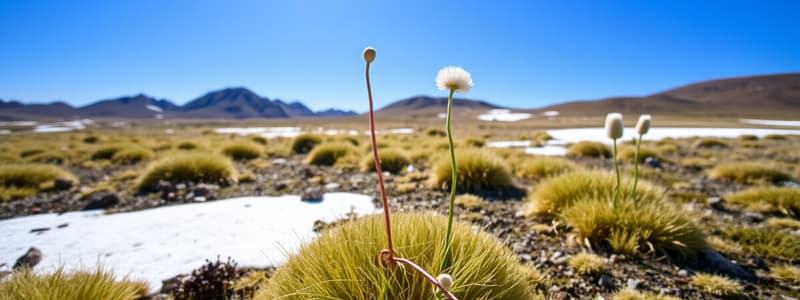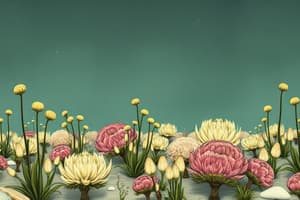Podcast
Questions and Answers
What adaptations help plants survive on the tundra?
What adaptations help plants survive on the tundra?
Tundra plants grow low to the ground and in mats or clumps.
What adaptations do animals have that protect them?
What adaptations do animals have that protect them?
Most tundra animals have stocky bodies covered with thick fur or feathers.
Below the active layer is permafrost, the permanently frozen layer of ground that can be as much as how many feet thick?
Below the active layer is permafrost, the permanently frozen layer of ground that can be as much as how many feet thick?
2000 feet
Why do tundra plant species grow low to the ground?
Why do tundra plant species grow low to the ground?
How do arctic plants survive in the winter?
How do arctic plants survive in the winter?
How have some plants adapted to this ecosystem?
How have some plants adapted to this ecosystem?
The arctic tundra includes what plants?
The arctic tundra includes what plants?
Like much tundra vegetation, what is a dense or loosely matted plant?
Like much tundra vegetation, what is a dense or loosely matted plant?
The tufted saxifrage stems can reach about how tall in height?
The tufted saxifrage stems can reach about how tall in height?
Tufted saxifrage flowers produce what?
Tufted saxifrage flowers produce what?
Why do tundra plants grow so close to the ground?
Why do tundra plants grow so close to the ground?
Why do some arctic plants have red or dark-colored leaves?
Why do some arctic plants have red or dark-colored leaves?
Flashcards are hidden until you start studying
Study Notes
Adaptations of Tundra Plants
- Tundra plants grow low to the ground to reduce exposure to harsh winds and cold temperatures.
- Growth in mats or clumps helps minimize exposure to heavy snowfall.
- Most Arctic plants reproduce through new roots due to the short growing season, rather than by producing seeds.
Surviving Harsh Conditions
- Arctic plant communities adapt to extreme conditions including cold winds, low temperatures, and limited sunlight.
- Dark leaves and stems enable some plants to capture more warmth from the sun, enhancing survival.
Permafrost and Its Extent
- Below the active layer of soil lies permafrost, which can reach thicknesses of up to 2000 feet.
Diversity of Arctic Vegetation
- Typical tundra plants include cotton grass, sedge, arctic willow, and dwarf heath.
- Tufted saxifrage, a common tundra plant, can exist in dense or loosely matted formations.
Characteristics of Tufted Saxifrage
- The stems of tufted saxifrage can grow to approximately 6 inches in height.
- The flowers of tufted saxifrage produce small fruits containing numerous tiny seeds.
Benefits of Low Growth
- Growing close to the ground helps tundra plants cope with the bitter cold and strong winds that characterize the tundra environment.
Color Adaptations for Heat Absorption
- Some arctic plants have red or dark-colored leaves to better absorb heat energy from sunlight, improving their survival chances in frigid conditions.
Studying That Suits You
Use AI to generate personalized quizzes and flashcards to suit your learning preferences.




